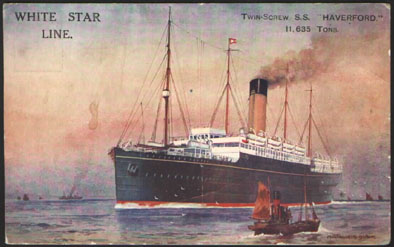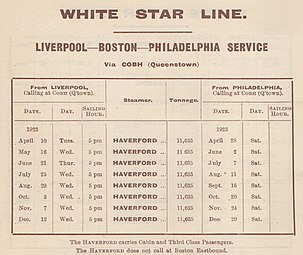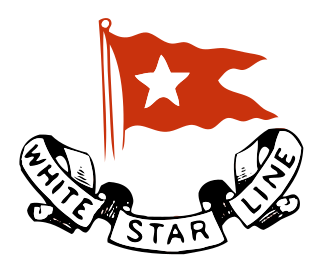
The White Star Line was a British shipping line. Founded out of the remains of a defunct packet company, it gradually rose up to become one of the most prominent shipping companies in the world, providing passenger and cargo services between the British Empire and the United States. While many other shipping lines focused primarily on speed, White Star branded their services by focusing more on providing comfortable passages for both upper class travellers and immigrants.
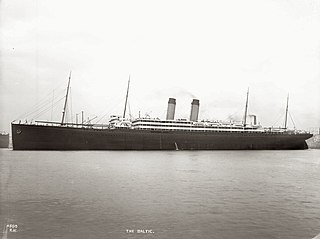
RMS Baltic was an ocean liner of the White Star Line that sailed between 1904 and 1932. At 23,876 gross register tonnage, she was the world's largest ship until May 1906. She was the third of a quartet of ships, all measuring over 20,000 gross register tons, dubbed The Big Four, the other three being RMS Celtic, RMS Cedric, and RMS Adriatic.

SSNaronic was a British cargo steamship built in 1892 by Harland and Wolff in Belfast, Ireland, for the White Star Line. A sister ship of SS Bovic, she was built at a time the company wanted to increase its market share in the transport of live cattle on the North Atlantic route. Along with other company's ships of the same type, she was responsible for transporting goods from Liverpool to New York City, United States, and bringing back American cattle on the return trip. She also had cabins that allowed her to carry a few passengers. At the time of her entry into service, Naronic was the largest cargo ship in operation.

RMS Celtic was an ocean liner owned by the White Star Line. The first ship larger than SS Great Eastern by gross register tonnage, Celtic was the first of a quartet of ships over 20,000 tons, the dubbed The Big Four. She was the last ship ordered by Thomas Henry Ismay before his death in 1899. The second liner of her name she was put into service in 1901. Her large size and her low but economical speed inaugurated a new company policy aiming to favour size, luxury and comfort, to the detriment of speed.

RMS Cedric was an ocean liner owned by the White Star Line. She was the second of a quartet of ships over 20,000 tons, dubbed the Big Four, and was the largest vessel in the world at the time of her entering service. Her career, peppered with collisions and minor incidents, took place mainly on the route from Liverpool to New York.

RMS Adriatic was a British ocean liner of the White Star Line. She was the fourth of a quartet of ships of more than 20,000 GRT, dubbed The Big Four. The ship was the only one of the four which was never the world's largest ship. However, she was the largest, the fastest, and the most luxurious of the Big Four, being the first ocean liner to have an indoor swimming pool and a Turkish bath.
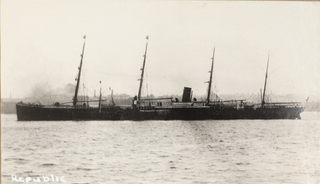
SS Republic was an ocean liner built in 1871 by Harland and Wolff for White Star Line. It was intended to be the last of four vessels forming the Oceanic-class, before two new ships were commissioned. After a rough maiden voyage from Liverpool to New York City on 1 February 1872, the ship was chosen to be on White Star Line's first voyage on the South Atlantic and Pacific line with four other ships, destined for Chile. In 1874, the construction of modern ships SS Germanic and SS Britannic led to SS Republic's becoming the standby vessel of White Star Line. It occupied this position for 15 years, and attempts were made to modernise it in 1888. When RMS Teutonic and RMS Majestic entered service in the following year, the Republic became surplus to White Star's needs.
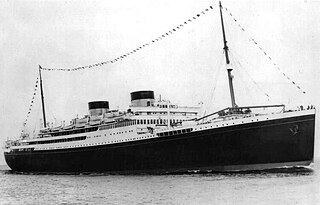
MV Britannic was a British transatlantic ocean liner that was launched in 1929 and scrapped in 1961. She was the penultimate ship built for White Star Line before its 1934 merger with Cunard Line. When built, Britannic was the largest motor ship in the UK Merchant Navy. Her running mate ship was the MV Georgic.

MV Georgic was the last ship built for the White Star Line before its merger with the Cunard Line. Built at Harland and Wolff shipyard in Belfast, she was the running mate of MV Britannic. Like Britannic, Georgic was a motorship, and not a steamer, fitted with a diesel powerplant. At the time of her launch in 1931, she was the largest British motorship.
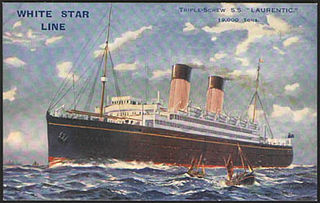
The second SS Laurentic was a 18,724 GRT steam ocean liner built in 1927 by Harland and Wolff, Belfast, for White Star Line. She was the last steamship to be built for White Star Line.
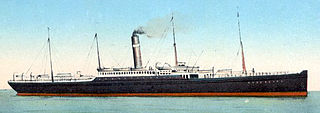
SS Merion was an ocean liner built in 1902 for the American Line, a subsidiary line of the International Mercantile Marine (IMM). She also sailed for the Red Star Line and the Dominion Line—both subsidiary lines of IMM—during her passenger career. After the outbreak of World War I she was bought by the British Admiralty and converted to serve as a decoy resembling the Royal Navy battlecruiser HMS Tiger. In May 1915, while posing as Tiger in the Aegean Sea, Merion was sunk by the German submarine SM UB-8.

SS Lapland was a steam ocean liner built in Ireland for the Belgian Red Star Line, as Red Star's flagship, similar in appearance to the fellow liners SS Samland, SS Gothland and SS Poland, but far larger. She was a half sister to White Star Line's "Big Four." They were similar in many ways, such as the island bridge, 4 masts, 2 funnels. But Lapland had a less luxurious interior.

SS Arabic was a British-registered ocean liner that entered service in 1903 for the White Star Line. She was sunk on 19 August 1915, during the First World War, by German submarine SM U-24, 50 mi (80 km) south of Kinsale, causing a diplomatic incident.

SS Doric was a British ocean liner operated by White Star Line. She was put into service in 1923. She was the second ship of the company to bear this name. Built by Harland and Wolff in Belfast, she was the company's second and last ship to be exclusively powered by turbines, after SS Vedic.

SS Doric was a British ocean liner operated by White Star Line. She was put into service in 1883. Built by the Harland and Wolff shipyards in Belfast, she was the sister ship of the Ionic which was put into service a few months earlier. Although the original purpose of the construction of the two ships was not known with certainty, both began their careers chartered by the New Zealand Shipping Co. which operated them on the route from London to Wellington.

SS Belgic was a steamship of the White Star Line. The first of the company's four ships bearing this name, she was first assigned, with her sister ship, the Gaelic on the route to France and South America, where the company has recently tried to establish itself. The experience was short-lived, however, and at the end of the year, the Belgic was the last White Star Line steamer to serve on this route. She was then moved to the North Atlantic route.

SS Delphic was an ocean liner of the White Star Line, built by Harland and Wolff in Belfast and completed on 15 May 1897. She worked the New Zealand trade. She was a fairly slow ship primarily intended for transporting emigrants and goods to New Zealand. Despite this, she made her first crossings on the New York route before joining the route to New Zealand. For twenty years, her service on this route was uneventful, with the exception of troop transport missions during the Second Boer War.

The SS American was a steamship built by Harland and Wolff in Belfast, which entered service in 1895. the American was a combined cargo and passenger ship which was originally built for the West India and Pacific Steamship Company along with her sister ship the SS European. In 1904 she passed to the White Star Line and was renamed Cufic, the name she retained until she was sold to Italian ownership in 1924, after which she became known as Antartico then Maria Guilia until being scrapped in 1932.

The SS European was a steamship built by Harland and Wolff in Belfast, which entered service in 1897. the European was a combined cargo and passenger ship which was originally built for the West India and Pacific Steamship Company along with her sister ship the SS American. In 1904 she passed to the White Star Line and was renamed Tropic, the name she retained until she was sold to Italian ownership in 1924, after which she became known as Artico then Transilvania until being scrapped in 1933.

The Jubilee class were a group of five passenger and cargo ocean liners built by Harland and Wolff at Belfast, for the White Star Line, specifically for the White Star Line's service from the UK to Australia on the Liverpool–Cape Town–Sydney route. The five ships in order of the dates they entered service were:



